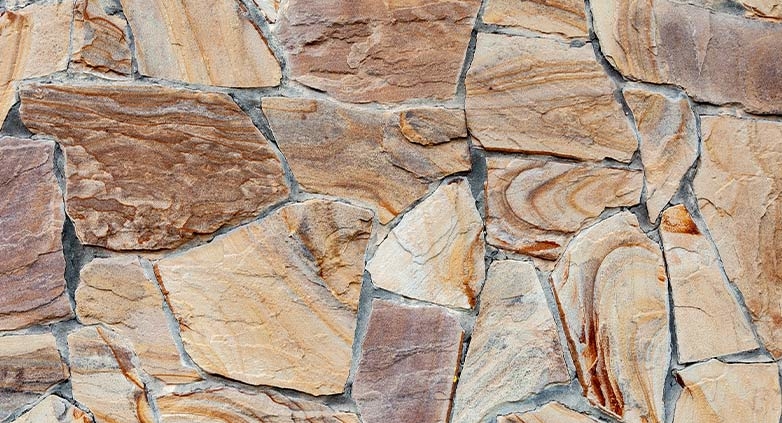Rainbow Sandstone – What Is It and When To Use It
Rainbow Sandstone stands as a testament to nature’s artistry, echoing the hues of a rainbow. Originating from India, this stone is crafted through layers of quartz and sand, intricately combined with minerals and iron oxides. These elements converge to create a signature spectrum of colors – from warm reds to deep blues. Its appeal extends beyond aesthetics; this sandstone is valued for its durability and weather-resistant qualities, making it a versatile choice for enhancing both indoor and outdoor spaces.
Rainbow Sandstone is a naturally occurring stone known for its striking stratifications that resemble a rainbow’s colors. Predominantly found in India, it is formed from finely grained quartz and sand. The layers of minerals and iron oxides within create unique, multicolored patterns, ranging from reds and oranges to purples and blues. Not only visually appealing, this sandstone is also praised for its hardwearing nature and resistance to weathering, making it a practical choice for both indoor and outdoor paving applications.
In our detailed exploration, we delve into the technical aspects that make Rainbow Sandstone a remarkable choice for paving and architectural projects. We’ll examine its composition and the factors contributing to its unique coloration, understand its physical properties like strength and porosity, and discuss practical considerations such as installation techniques and maintenance requirements. By providing a comprehensive overview of its characteristics, we aim to equip you with the knowledge necessary to effectively utilize this material in your next design venture.
What Is Rainbow Sandstone?
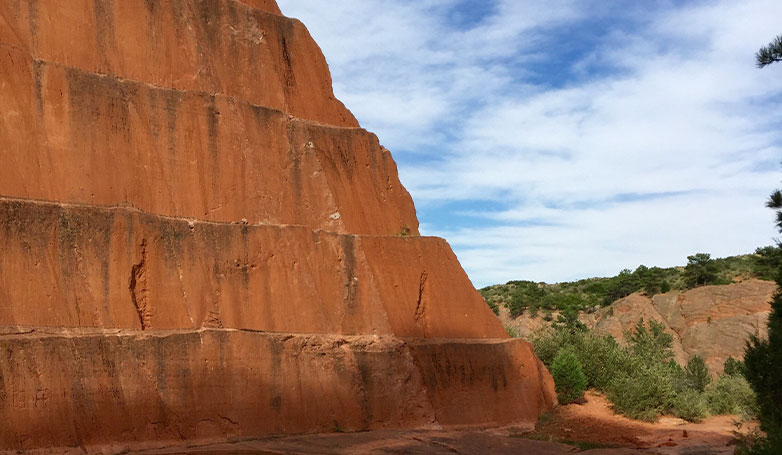
Rainbow sandstone, found in the quarries of Rajasthan’s Nagaur District, is a distinctive type of sandstone. Sometimes referred to as Khatu or Indian Sandstone, one of its unique characteristics is the thin lines or stripes of color that run across its surface, including shades of red, violet, and brown.
With these veins running in parallel with each other, the stone ends up having a rainbow look.
Beyond its rainbow-like aesthetic, it also has a smooth finish, making it wonderful for both interior and exterior projects, especially for those who want an added luxurious feel.
When adding premium-grade sandstone to your home, you can bring a warm and charming natural quality that catches the eye. Every stone offers a unique pattern with varying swirls of color. On the surface, it’s pretty easy to see why this has become such a popular stone.
Characteristics of Rainbow Sandstone
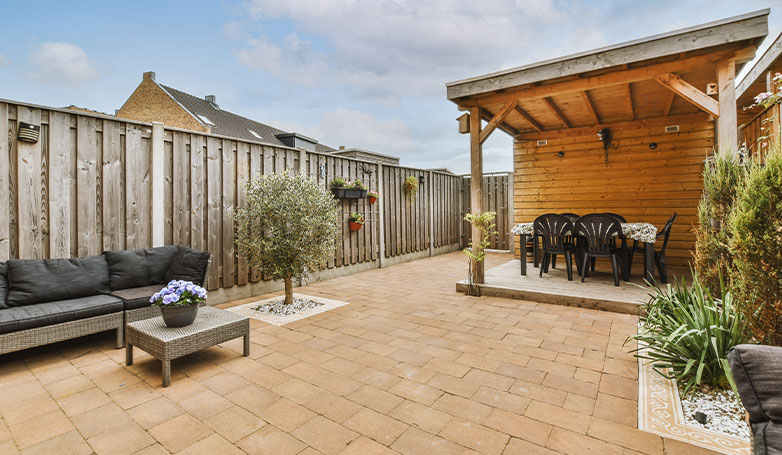
Rainbow Sandstone’s unique qualities make it a standout choice in construction and design. From vibrant hues to enduring durability, this material offers versatility and visual allure. Let’s explore its distinctive features.
Composition and Form
Transformed into various shapes and sizes to cater to diverse design requirements, this stone is available in slabs, which are large, continuous pieces ideal for expansive paving and paneling, creating a seamless and grand appearance. Tiles are another form, offering flexibility for detailed and intricate designs in both flooring and wall applications. For a touch of elegance in kitchens and bathrooms, countertops made of this stone present a unique and luxurious aesthetic, highlighting the natural beauty and patterns of the material.
Versatile Applications
Its striking visual appeal and robustness make this natural stone a versatile choice for multiple applications. As flooring, it introduces an element of nature’s artistry, enhancing the space with vibrant colors. When used as wall tiles, it becomes a centerpiece, adding character to any interior or exterior space. The stone’s durability and distinctive coloration make it a practical yet opulent choice for countertops, blending functionality with style.
Finishing Techniques
The finishing of Rainbow sandstone can vary, each method offering a unique texture and aesthetic. Flamed finishing roughens the surface, creating a natural, rustic look that is slip-resistant, ideal for outdoor environments. Gangsaw finishing produces smooth, even surfaces, perfect for large-area applications where uniformity is key. Polishing enhances the stone’s colors, giving it a glossy, refined appearance suitable for sophisticated indoor settings.
Aesthetic Appeal
Despite its name, the primary color palette of this unique stone is rooted in various shades of brown, interspersed with hues like red, blue, and purple. These colors blend seamlessly, offering a warm and inviting ambiance suitable for various design themes.
Geographic Origin
Originating from India, Rainbow Sandstone is a testament to the country’s rich geological diversity. The unique environmental and geological conditions of the region are responsible for the stone’s distinct color patterns and physical properties, contributing to its popularity and demand in the global market.
How to Lay Rainbow Sandstone in 11 Detailed Steps
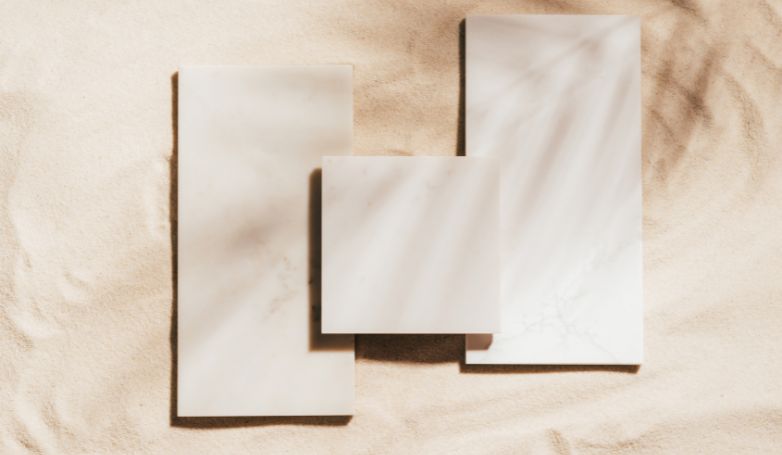
Laying Rainbow Sandstone is both an art and a science, requiring meticulous planning and execution. This guide is designed to walk you through the process, ensuring that each step is carried out with precision for a flawless finish. From site preparation to the final curing, these steps are tailored to help both beginners and experienced DIY enthusiasts achieve professional results with Rainbow Sandstone paving.
Now, let’s dive into the detailed steps.
1. Site Preparation
Before you start laying your Rainbow Sandstone, it’s imperative to carefully select and prepare the site. Begin by identifying the exact area where the sandstone will be laid. This area should ideally be level, stable, and have good drainage to prevent water accumulation. To precisely delineate the area, use spray paint to mark the boundaries. This visual representation is not only helpful for planning but also ensures you stay within the designated space during the installation process. Take your time to assess the terrain and its suitability for paving, considering factors like soil type and potential water flow.
2. Excavation
The next step involves excavating the marked area. Dig to a depth of at least 125mm, plus the additional depth of the sandstone paving material. This process is crucial for creating a stable base and ensuring the longevity of your paving. It’s important to remove all the topsoil and vegetation from this area, as organic materials can decompose over time, causing the pavement to settle unevenly. After you finish digging, check that you have a consistent depth of at least 150mm throughout the area, as this will form the base for your sub-base material and the paving stones.
3. Leveling the Base
Once the area is excavated, focus on leveling. Use measuring tools like falls and string lines to ensure an even surface. This is critical for preventing water pooling and ensuring a uniform paving height. After setting your guides, compact the area thoroughly using a tamper or a garden roller. A well-compacted and level base is essential for the stability of the sandstone and will prevent shifting or sinking over time.
4. Sub-base Installation
After leveling, it’s time to lay the sub-base. This layer can be made of various materials, including quarry dust or crushed stone. Start by adding a 50mm layer of your chosen sub-base material. Compact this layer firmly, then add another 50mm layer on top, compacting again to achieve a total depth of 100mm. A solid sub-base provides a stable foundation for the sandstone, and compacting each layer ensures that the base won’t settle or shift after the stone is laid.
PRO TIP: Remember to create a slight gradient or incorporate drainage solutions in your sub-base to facilitate water runoff.
5. Cleaning the Stones
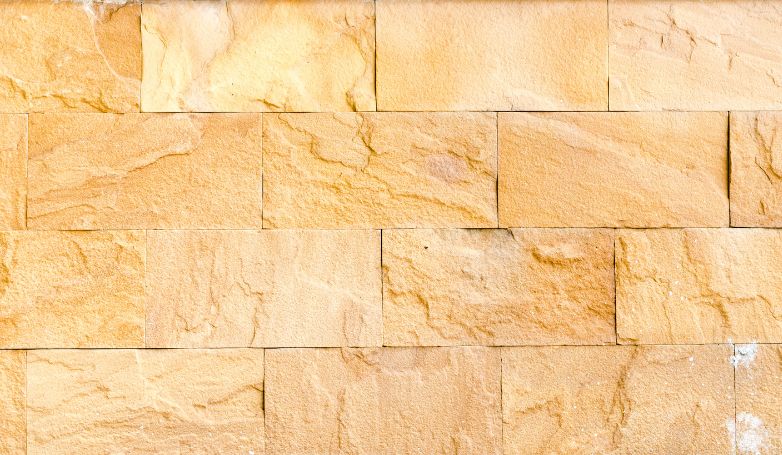
Before laying the stones, it’s crucial to clean them. This step removes any dust, dirt, or debris that might hinder the adhesion of the stone to the mortar. Use a gentle sponge and water to clean the surface of each stone. Be thorough but gentle to avoid damaging the stone’s natural finish.
6. Priming the Stones
Priming the stones is a step often overlooked, but it significantly improves the bond between the stone and the mortar. Use a fine mortar slurry or a proprietary priming product, applying it evenly to the back of each stone. This process ensures a stronger, more durable bond, which is particularly important in outdoor settings where the stone will be exposed to varying weather conditions.
7. Mortar Preparation
The mortar mix is a critical component of laying Rainbow sandstone. Mix four parts sand with one part cement, adding water until you achieve a wet, workable consistency. The right consistency is crucial; too dry, and the mortar won’t bond properly, too wet, and it won’t support the weight of the stones.
8. Applying the Mortar
Begin by applying the mortar mix to a small, manageable section of your base. Spread it evenly, maintaining a thickness of around 30mm. This layer acts as a bed for the sandstone, providing a level surface and ensuring each stone is adequately supported.
9. Stone Placement
Carefully place each sandstone unit onto the mortar bed, maintaining a gap of approximately 8 to 10mm between each stone. This spacing is important for the jointing process later. Use a rubber mallet to gently but firmly tap each stone into place, ensuring they are level and securely embedded in the mortar.
10. Jointing
After laying the stones, prepare a fresh batch of mortar for jointing. Apply this mortar mix to the gaps between the stones using a trowel, ensuring the joints are completely filled. Use a pointing tool to compact the mortar into the joints, which secures the stones and provides a finished look to your paving.
11. Curing
Finally, allow the newly laid Rainbow Sandstone to set and cure. This process usually takes at least 24 hours but can be longer in humid or wet conditions. Avoid walking on or applying pressure to the paving during this time to ensure a strong and even setting of the mortar and stones.
By following these detailed steps, you can lay Rainbow Sandstone paving that is not only aesthetically pleasing but also durable and long-lasting.
What Is The Best Sandstone?
Determining the best sandstone depends on the specific requirements of your project and personal preferences.
However, some widely regarded and high-quality sandstones include
Rainbow Sandstone
Celebrated for its vibrant color palette and versatility, Rainbow Sandstone is a visually striking option for various construction and design applications. Its unique hues and patterns make it an attractive choice for those looking to make a bold statement in their projects.
Bansi Pink Sandstone
Bansi Pink Sandstone is renowned for its subtle pink hues and exceptional durability. Often chosen for applications such as flooring and cladding, this sandstone adds a touch of sophistication to both interior and exterior spaces.
Teakwood Sandstone
For those seeking warmth and unique patterns, Teakwood Sandstone is an excellent choice. Its earthy tones and wood-like textures make it a preferred option for creating a natural and elegant ambiance in various settings.
Agra Red Sandstone
Characterized by its rich red color and fine-grained texture, Agra Red Sandstone is frequently selected for intricate carvings and detailing in architectural elements. It adds a touch of grandeur to designs, especially when aiming for a traditional or classic aesthetic.
Gwalior Mint Sandstone
Gwalior Mint Sandstone stands out with its natural mint color and long-lasting appearance. This sandstone is prized for its ability to retain its visual appeal over time, making it a suitable choice for both traditional and contemporary designs.
Consider these high-quality sandstone options based on your preferences, intended use, and the aesthetic you aim to achieve in your project.
How Long Does Rainbow Sandstone Last?
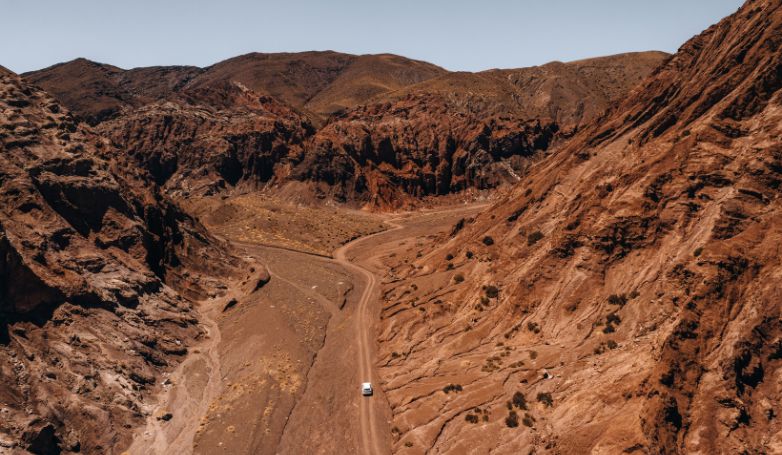
If installed and maintained with proper care, Rainbow Sandstone can last for a very long time. On the other hand, if you install it on the cheap, don’t provide it with care, or use low-quality materials, you might only be able to expect anywhere from 2-10 years out of it.
With the right materials, a solid base, and proper care (ex. Repointing every couple of years), you can get anywhere from 30 to 50 years out of your sandstone.
There are many Rainbow Sandstone paths that have been down for more than 100 years without moving very much.
Does Indian Sandstone Keep Its Color?
Some people note that they have issues with their Indian Sandstone changing colors after a certain period. Depending on the type of sandstone you have and the conditions it is in, it can often turn yellow over time.
One of the best ways to get sandstone to return to its original color is by treating it with an acidic solution. Some people will even go as far as staining their sandstone if it is not sealed, which can give it an entirely different color altogether. However, the susceptibility of sandstone staining depends a lot on the density of the stone in question.
Some sandstone is much more porous than other types.
What Is The Best Indian Sandstone Color?
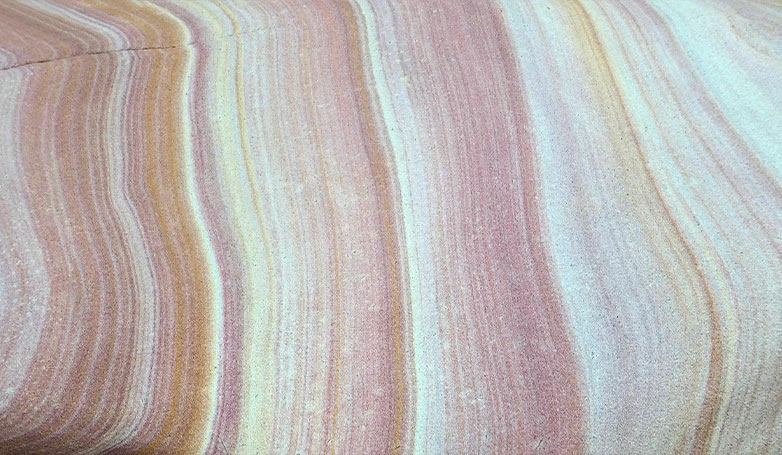
While there are many different colors of Indian Sandstone to choose from, one of the most popular on the current market (and for a good reason) is Raj Green. This color of Indian Sandstone offers a unique mix of earthy browns and greens that are very complementary when put alongside natural landscapes with grass and foliage.
Beyond that, Raj Green is one of the most versatile types of Indian Sandstone around, allowing you to use it for a number of unique projects.
Of course, there are many other colors to choose from as well, including grey, light grey, mint, and brown. Modac is a very popular color due to the fact that it changes color when wet. When dry, it looks like a blend of orange, plum, and pink. However, when wet, it looks more earthy.
Rainbow Sandstone Paving Ideas
Here are some ideas for using this material.
Outdoor Patio
Rainbow Sandstone has an earthy look that works well with outdoor spaces. Thanks to the shades of green in many types of sandstone, it works naturally when set in next to grassy areas or gardens with plenty of foliage.
Take a look at this simple Rainbow Sandstone patio with a brick outline sitting next to a large grassy lawn.
Pool Area
Rainbow Sandstone works great next to pools for several reasons.
For starters, it has a slight texture on the surface that keeps it from getting too slick when wet, which can keep those hanging out around the pool safe at all times.
Secondly, many types of Rainbow Sandstone will have a slight change in color when wet, which results in a unique multicolor aesthetic that you can’t get from many other types of stones.
Check out some of the ways people have incorporated Rainbow Sandstone into their pool areas.
Pros of Rainbow Sandstone Paving
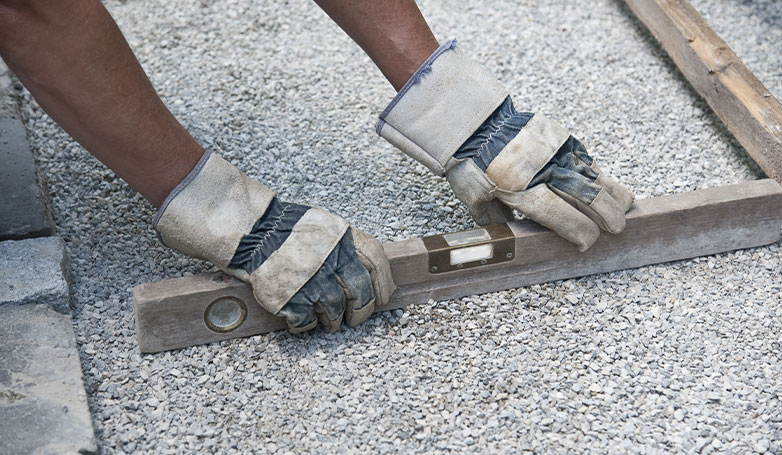
Rainbow sandstone has many advantages, here are all the ones we found!
Durability
While Rainbow Sandstone isn’t as durable as slate or granite, it is more than durable enough to last for many years if properly taken care of. Once installed, Rainbow Sandstone can last for many decades, even in environments that receive inclement weather often.
Beauty
There is an undeniable and ineffable quality in Rainbow Sandstone that is difficult to find elsewhere. This natural beauty complements many spaces and designs, offering a range of colors from green to white to brown and beyond. The stretch of hues is so versatile, making it great for several projects. Beyond that, its earthy texture is something you won’t find in any imitations.
Easy To Replace
Because you install sandstone flooring using individual pieces and tiles, you can easily remove and replace tiles if they crack or break. We always recommend saving some tiles from your initial installation in case anything happens. It can be difficult to source the exact color of Rainbow Sandstone tile years down the line, if not impossible. This is why many quarries will stop producing certain varieties for a number of reasons.
Uniqueness
Sandstone pavers are all-natural. This means that every color, pattern, or hue found in these pavers is totally unique. When these massive slabs of stone are mined from the Earthy, they are cut into smaller pieces.
A builder can then rearrange these pieces at random to turn them into a masterful piece of architecture.
Cons of Rainbow Sandstone Paving
Of course, there are also many drawbacks to using Rainbow Sandstone as well, which are worth noting if you’re planning on making a big investment for a paving project.
Can Scratch
Rainbow Sandstone is a natural rock. Compared to many types of natural stone, however, it is very soft. This means that it is susceptible to dents and scratches over time. Dropping some heavy can easily crack a tile, or stepping the wrong way in a high heel can leave nasty scratches.
High Water Absorption
Most Sandstone is very porous. In fact, the absorption rate of most types of sandstone is 6%, meaning it is more vulnerable to damage than other types of stone. If you live in extreme conditions, your Rainbow Sandstone could suffer from warping, liquid stains, molds, and micro-bacteria if not properly sealed and cared for.
If you are planning to install that Sandstone in a kitchen, bathroom, or pool area, spending time sealing it is extremely important.
Cost
Rainbow Sandstone can get very expensive very fast. People often ask how much it costs for certain projects, such as paving a driveway. While it can certainly look a lot nicer than concrete, it will also cost a lot more.
Rainbow (and/or Indian) Sandstone Paving Problems
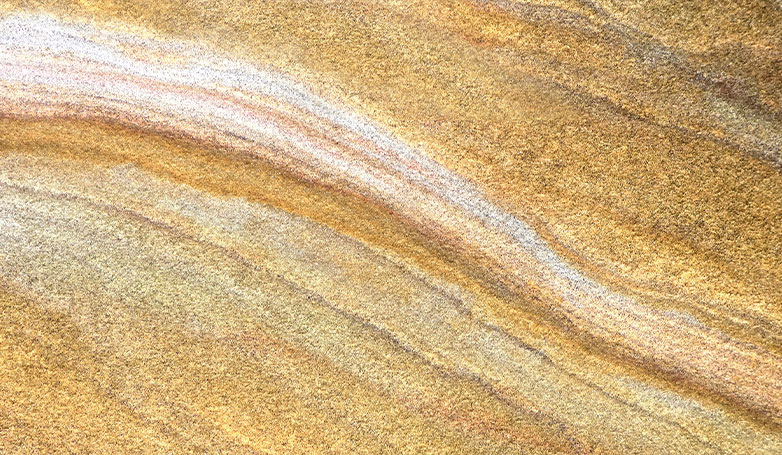
When selecting Rainbow or Indian Sandstone for paving, it’s important to be aware of certain challenges that can arise over time. These issues, if not addressed properly, can significantly impact both the functionality and aesthetic value of the stone paving. Now, let’s delve into the specifics of these problems and explore effective ways to mitigate them.
Durability Concerns: Softening and Brittleness Over Time
One of the primary challenges with Indian Sandstone, especially the colorful Rainbow variety, is its tendency to become soft and brittle with age. This issue is exacerbated when the stone is subjected to harsh environmental elements, leading to problems like chipping, cracking, or even complete breakage. Such deterioration not only affects the physical integrity of the paving but also its aesthetic appeal, potentially compromising the overall look and safety of the area.
Color Fading: Loss of Vibrancy
Another significant concern for is its vulnerability to color fading. Continuous exposure to factors like sunlight, weathering, and erosion can gradually dull the vibrant hues that make this stone so attractive. The fading of colors is not just a cosmetic issue; it can also impact the property’s value and overall appeal.
Prevention and Maintenance: Quality and Sealing
To mitigate these issues, the initial focus should be on sourcing high-quality sandstone. Premium quality materials are more resilient to environmental stress and less prone to rapid deterioration. Furthermore, applying a suitable sealant to the sandstone can effectively safeguard it. A robust sealant acts as a barrier, protecting against moisture, UV damage, and other external factors, thereby extending the stone’s lifespan and preserving its color. Regular maintenance, including periodic cleaning and resealing, is also crucial in maintaining the longevity and beauty of Rainbow Sandstone paving.
Final Thoughts
Whether you’re paving a driveway, creating a garden patio, or putting in some new steps next to the pool, Rainbow Sandstone is a great paving choice. It is certainly a higher-priced paving slab compared to many others, though it can provide a blend of earthiness and luxury that you won’t find in many other types of stone.
We highly recommend it for any kind of outdoor project!
For more information on paving projects, head over to our blog, where we share our expert advice on paving with all types of materials!

